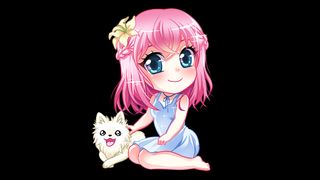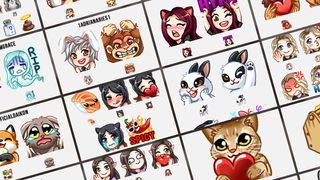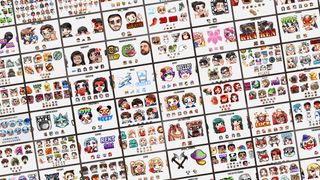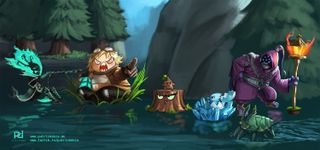What it's like making a living from designing Twitch emotes
"Never settle for less than minimum wage," says illustrator Allison Henderson.

Allison Henderson's specialty are her portraits. If you click through her website, you'll find the champions of League of Legends, Overwatch, and Heroes of the Storm illustrated in scrupulous detail; a serene Tracer, mid-teleport, aims her pulse pistols at an unseen interloper, an ashen Widowmaker brandishes her sniper rifle against Hanamura's famous cherry blossoms. This is an uncommon skillset—not everyone has a keen eye for emotional subtlety and a deep love of videogames—and it's exactly what made Henderson one of the most in-demand emote designers on Twitch.
For the uninitiated, Twitch emotes are those microscopic chibis you see spammed into the chatbox of pretty much every stream on the platform. The global ones are famous—Pogchamp, Kappa, Trihex—and they've each taken on their own semantic definition within the community. However, if you're a partner on Twitch, you can also dish out custom emotes for the people who put up the five dollars a month to subscribe to your channel, which is one of the primary ways for Twitch streamers to monetize their work. Outside of a few basic rules laid out by the top brass (no profanity, no copyright infringement, a maximum of two Kappa derivatives,) those channel-exclusive emotes can be pretty much anything, and that's opened up a brand new hyper-niche market for artists.

The vast majority of streamers aren't great with a Wacom tablet, but Henderson is, so they started hiring her to create their emotes. In the past she made her bones by selling prints at anime conventions and scoring the occasional corporate gig, but now she estimates that 90 percent of her income comes from Twitch emote commissions. "I think at one point I was doing upwards of 20 shows in a year and I can tell you it was much more exhausting than what I do now," she says to me, over email. "When I picked up doing emotes I slowly started to diminish my bookings and now I am a full time freelancer."
Henderson credits a lot of her success to the social following she had before she jumped in the emote game full-time. 24,000 followers on Twitter, 5,600 more on Instagram, all earned from her dazzling fan art. The first streamer she worked with was Trick2G—a prominent League player with over 100 million total views. He was a friend of her boyfriend, and he also needed some emotes to flesh out his brand. "I felt it more of a favor than a job," remembers Henderson. She mocked up seven tiny portraits, Trick was pleased, and he still uses two of them on his stream.
That was back in 2015, and Henderson tells me it was 2016 when her emote business emerged as a career. I recommend perusing the gallery in her portfolio if you're curious—there are literally dozens of sequined, miniaturized toons spilling off the page. You can find Eeveea, and Codyniku, and Anniefuchsia. Truly, no one on the internet has spent more time kawaii-ifying the Twitch intelligentsia than Henderson.

The first emotes she sold were priced at $15 each, which is a premium far more suited to a side hustle than a breadwinning concern. But soon enough she stopped shortchanging herself, and upped the cost to $40, $50, and finally $65. "You might think that's an awful lot to charge for a very small drawing but my rate is based on a careful consideration of time spent, commercial value, and demand," Henderson explains. "I made adjustments to pursue [this career.]"
The toughest part of the job, says Henderson, is the small scale of the designs. On stream, Twitch icons appear in a 28x28 pixel frame. That is tiny. Smaller than the end of your pinky finger. She quickly learned that when you're drawing something that little, the clarity of the image can get muddled very quickly. "When I started a lot of my drawings were overly detailed and became cluttered when I resized them," says Henderson. "To achieve this I used a lot of thick lines and simple shapes to create the characters and animals my clients wanted. It was a lot of 'draw things as simply as you can' at the beginning but now through the years of experience I was able to add back some of the details that I would've been too afraid to use in the beginning."
The biggest gaming news, reviews and hardware deals
Keep up to date with the most important stories and the best deals, as picked by the PC Gamer team.
This is something that Patrick Deza, another emote designer who's worked with people like Anniebot and Dyrus, also mentions: "[The size] is especially a problem when streamers request words in their emotes. Four letters are fine, anything beyond might be hard to read depending on the letters of the words. There is no certain approach to solve this issue, other than creating a lot of emotes and getting more experienced."

If you are interested in making this your job, please do general research on being a freelancer and don't be afraid to raise your prices.
Allison Henderson
The most enjoyable part of the job? Spitballing ideas with the streamers themselves. Both Deza and Henderson tell me that there's no creative formula to the commission process, instead they do their best to suss out exactly what their customers will respond to. Sometimes it's just a word or a feeling, "happy, rage, or love," says Henderson. Sometimes it's almost frighteningly specific, "Alkrin asked me to draw his cat doing various things such as hiding in a trash can or crying," remembers Deza.
Unlike Henderson, Deza doesn't design emotes full-time, but he still charges a sizable 50€ (or $61) fee. This is something that's important to both of them. There's been a lot of buzz over the years about the devaluation of an artist's work in the internet age, when copyright law feels more like a limp suggestion rather than an enforceable rule. And of course, there is no perfect precedent for how much an emote should cost, which means it's truly up to the creatives themselves to demand a better paycheck.
Henderson is the most candid about this. She's seen other artists on the internet sell their wares for $10 or $15. Henderson understands where they're coming from—there are plenty of hobbyists who aren't necessarily trying to draw full-time—but she does believe that people in this field need to stand up for themselves.
Above: Henderson often streams her work on Twitch.
"Often when taking into consideration the back and forth with a client, the time spent actually drawing and then fees for Paypal, it's much lower than minimum wage," says Henderson. "Not to mention, emotes are generating revenue for streamers—you sub for emotes—so realistically the artwork should be valued commercially."
"If you are interested in making this your job, please do general research on being a freelancer and don't be afraid to raise your prices. Do not allow yourself to be bullied into compromising, be confident and stick up for yourself. I have seen and experienced this myself in the past where someone will try to haggle or ask for discounts or straight up say, 'Your art isn't worth that much money!' I know that sometimes artists will doubt themselves if they are not getting enough work, but most of the time that is more about the amount of exposure they have versus their prices. It's definitely a balancing act and there's no 'golden' number which makes it difficult to talk about, but never settle for less than minimum wage."
It's interesting that we're approaching an era where Twitch, a company ostensibly about people playing videogames on camera, is already splintering off into extraneous commercial veins. Plenty of responsibility comes with that, and I hope that the company is paying attention to the tail of freelance laborers that they've created and incentivized, but mostly I'm happy that artists—and especially fan artists, who've been marginalized for years—have a legitimate new monetization avenue. Work is work, even if it's coming in 784-pixel doses.

Luke Winkie is a freelance journalist and contributor to many publications, including PC Gamer, The New York Times, Gawker, Slate, and Mel Magazine. In between bouts of writing about Hearthstone, World of Warcraft and Twitch culture here on PC Gamer, Luke also publishes the newsletter On Posting. As a self-described "chronic poster," Luke has "spent hours deep-scrolling through surreptitious Likes tabs to uncover the root of intra-publication beef and broken down quote-tweet animosity like it’s Super Bowl tape." When he graduated from journalism school, he had no idea how bad it was going to get.
Most Popular

